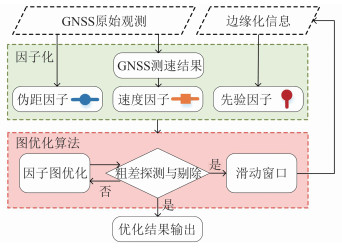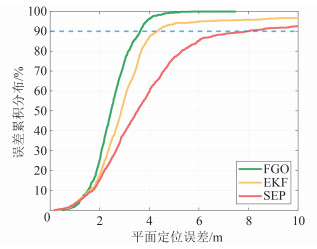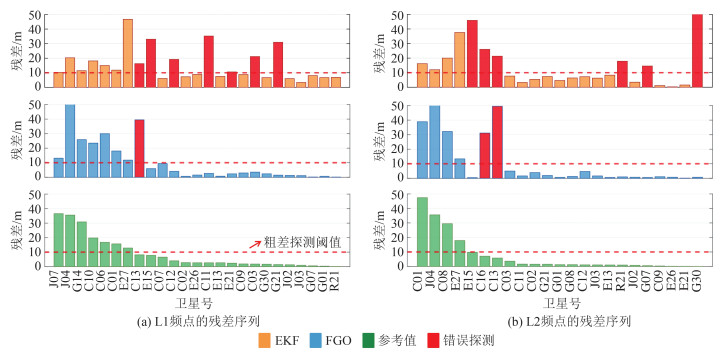Factor Graph Optimization for Urban Environment GNSS Positioning and Robust Performance Analysis
-
摘要: 北斗/全球导航卫星系统(global navigation satellite system, GNSS)在开阔环境下可以提供连续可靠的高精度导航定位服务,但是在城市复杂场景下,GNSS多路径与非视距信号严重、粗差与周跳发生频繁,导航定位能力仍然存在不足。相较于扩展卡尔曼滤波(extended Kalman filter, EKF)方法,因子图优化能够充分利用历史观测,通过窗口内历元间约束与冗余观测信息共同抑制异常数据影响。构建了基于滑动窗口因子图优化的GNSS定位模型,通过验后残差迭代分析进行粗差探测,并从最小可探测误差、粗差探测成功率、定位精度提升等方面深入分析因子图优化与EKF的抗差性能。以城市复杂场景数据进行处理验证,结果表明,因子图优化的最小可探测误差减小了11.92%~32.56%,粗差探测成功率提升了3.84%~10.47%,GNSS定位精度提升了11.29%~25.99%。总体而言,对于城市复杂场景下的GNSS导航定位应用,因子图优化具备更好的抗差性能和定位精度,有望取代现有基于单历元观测值的EKF模型。Abstract:Objectives BeiDou satellite navigation system (BeiDou)/global navigation satellite system(GNSS) can provide continuous and reliable high-precision navigation and positioning service in open-sky, yet in urban environment, suffering from outliers and cycle slips caused by severe multi-path and non-line-of-sight signals, the navigation and positioning capability remains inadequate. Compared with the extended Kalman filter (EKF), factor graph optimization (FGO) can make full use of historical measurements and restrain the influence of anomalous data through constraints and redundant measurements inside the window.Methods A GNSS positioning model based on sliding-window FGO is constructed, adopting posteriori residuals test as outlier detection method, and analysis of robust performance between EKF and FGO is presented in terms of minimum detectable bias, correct detection rate and positioning accuracy.Results The result of urban environment experiment shows that the minimum detectable bias is reduced by 11.92%-32.56%, the correct detection rate is improved by 3.84%-10.47%, and the GNSS positioning accuracy is improved by 11.29%-25.99%.Conclusions Overall, for Application of GNSS navigation and positioning in urban environment, FGO has better robustness and positioning accuracy, could replace EKF models based on single epoch observations.
-
-
表 1 解算策略
Table 1 Processing Strategy
项目 策略 观测数据 多频多系统数据 星历 广播星历 截止高度角/(°) 15 截止信噪比/dBHz 20 速度约束 GNSS测速结果 随机模型 高度角模型 粗差探测策略 卡方检验+最大化残差 表 2 实验数据信息
Table 2 Information of Experiment Data
统计项 测量型设备实验 低成本设备实验 采集地点 上海市 武汉市 采集设备 NovAtel SPAN u-blox 采集时间 2022-03-09 2019-08-01 数据时长/min 20 50 采样间隔/s 1 1 实验场景 城市车载 城市车载 解算频点 G:L1/L2
C:B1/B2
E:E1/E5a
R:L1/L2
J:L1/L2G:L1
C:B1
E:E1注:G、C、E、R、J分别代表GPS、BDS、Galileo、GLONASS、QZSS卫星。 表 3 实验一结果统计
Table 3 Results Statistics of Experiment 1
模型 定位误差RMS/m $ \overline{\mathrm{M}\mathrm{D}\mathrm{B}} $/m CDR/% E N U EKF 1.908 2.951 4.033 2.340 66.13 FGO 0.934 2.473 3.941 2.061 76.60 表 4 实验二结果统计
Table 4 Results Statistics of Experiment 2
模型 定位误差RMS/m $ \overline{\mathrm{M}\mathrm{D}\mathrm{B}} $/m CDR/% E N U EKF 0.859 1.098 2.207 5.565 66.43 FGO 0.825 0.925 1.482 3.753 70.27 -
[1] Pan L, Zhang X, Liu J, et al. Performance Evaluation of Single-frequency Precise Point Positioning with GPS, GLONASS, BeiDou and Galileo[J]. The Journal of Navigation, 2017, 70(3): 465-482. doi: 10.1017/S0373463316000771
[2] 耿江辉, 常华, 郭将, 等. 面向城市复杂环境的3种多频多系统GNSS单点高精度定位方法及性能分析[J]. 测绘学报, 2020, 49(1): 1-13. https://www.cnki.com.cn/Article/CJFDTOTAL-CHXB202001001.htm Geng Jianghui, Chang Hua, Guo Jiang, et al. Three Multi-frequency and Multi-system GNSS High-Precision Point Positioning Methods and Their Performance in Complex Urban Environment[J]. Acta Geodaetica et Cartographica Sinica, 2020, 49(1): 1-13 https://www.cnki.com.cn/Article/CJFDTOTAL-CHXB202001001.htm
[3] 张小红, 陶贤露, 王颖喆, 等. 城市场景智能手机GNSS/MEMS融合车载高精度定位[J]. 武汉大学学报(信息科学版), 2022, 47(10): 1740-1749. doi: 10.13203/j.whugis20220611 Zhang Xiaohong, Tao Xianlu, Wang Yingzhe, et al. MEMS-Enhanced Smartphone GNSS High-Precision Positioning for Vehicular Navigation in Urban Conditions[J]. Geomatics and Information Science of Wuhan University, 2022, 47(10): 1740-1749 doi: 10.13203/j.whugis20220611
[4] Takasu T, Yasuda A. Development of the Low-Cost RTK-GPS Receiver with an Open Source Program Package RTKLIB[C]//International Symposium on GPS/GNSS, International Convention Center Jeju Korea Seogwiposi, Korea, 2009.
[5] Watson R M, Gross J N. Robust Navigation in GNSS Degraded Environment Using Graph Optimization[C]//The 30th International Technical Meeting of the Satellite Division of the Institute of Navigation (ION GNSS+ 2017), Portland, Oregon, USA, 2017.
[6] Kschischang F R, Frey B J, Loeliger H A. Factor Graphs and the Sum-Product Algorithm[J]. IEEE Transactions on Information Theory, 2001, 47(2): 498-519. doi: 10.1109/18.910572
[7] Dellaert F, Kaess M. Square Root SAM: Simultaneous Localization and Mapping via Square Root Information Smoothing[J]. The International Journal of Robotics Research, 2006, 25(12): 1181-1203. doi: 10.1177/0278364906072768
[8] 王金科, 左星星, 赵祥瑞, 等. 多源融合SLAM的现状与挑战[J]. 中国图象图形学报, 2022, 27(2): 368-389. https://www.cnki.com.cn/Article/CJFDTOTAL-ZGTB202202005.htm Wang Jinke, Zuo Xingxing, Zhao Xiangrui, et al. Review of Multi-source Fusion SLAM: Current Status and Challenges[J]. Journal of Image and Graphics, 2022, 27(2): 368-389 https://www.cnki.com.cn/Article/CJFDTOTAL-ZGTB202202005.htm
[9] Suzuki T. First Place Award Winner of the Smartphone Decimeter Challenge: Global Optimization of Position and Velocity by Factor Graph Optimization[C]//The 34th International Technical Meeting of the Satellite Division of the Institute of Navigation (ION GNSS+ 2021), LouisSt., Missouri, 2021.
[10] Suzuki T. 1st Place Winner of the Smartphone Decimeter Challenge: Two-Step Optimization of Velocity and Position Using Smartphone's Carrier Phase Observations[C]//The 35th International Technical Meeting of the Satellite Division of the Institute of Navigation, Denver, USA, 2022.
[11] Watson R M, Gross J N. Evaluation of Kinematic Precise Point Positioning Convergence with an Incremental Graph Optimizer[C]//2018 IEEE/ION Position, Location and Navigation Symposium (PLANS), Monterey, CA, USA, 2018.
[12] Wen W, Hsu L T. Towards Robust GNSS Positioning and Real-time Kinematic Using Factor Graph Optimization[C]//2021 IEEE International Conference on Robotics and Automation (ICRA), Xi'an, China, 2021.
[13] Gao H, Li H, Huo H, et al. Robust GNSS Real-Time Kinematic with Ambiguity Resolution in Factor Graph Optimization[C]//2022 International Technical Meeting of the Institute of Navigation, Long Beach, California, 2022.
[14] 徐浪, 陈晓东, 黄攀. 基于因子图优化的GNSS定位算法研究[C]//第十三届中国卫星导航年会: 自主导航与智能运行, 中国北京, 2022. Xu Lang, Chen Xiaodong, Huang Pan. An Improved GNSS Positioning Algorithm Based on Factor Graph Optimization[C]//The 13rd China Satellite Navigation Conference: Autonomous Navigation and Intelligent Operation, Beijing, China, 2022
[15] Bai X, Wen W, Hsu L T. Time-Correlated Window-Carrier-Phase-Aided GNSS Positioning Using Factor Graph Optimization for Urban Positioning[J]. IEEE Transactions on Aerospace and Electronic Systems, 2022, 58(4): 3370-3384. doi: 10.1109/TAES.2022.3149730
[16] Jiang Y, Gao Y, Ding W, et al. GNSS Precise Positioning for Smartphones Based on the Integration of Factor Graph Optimization and Solution Separation[J]. Measurement, 2022, 203: 111924. doi: 10.1016/j.measurement.2022.111924
[17] Sibley G, Matthies L, Sukhatme G. Sliding Window Filter with Application to Planetary Landing[J]. Journal of Field Robotics, 2010, 27(5): 587-608. doi: 10.1002/rob.20360






 下载:
下载:












